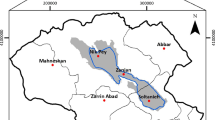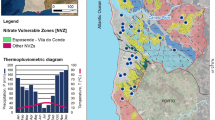Abstract
The main purpose of this study was to model nitrate and its spatial and temporal variations under hydrological tensions. For this purpose, the hydrodynamic characteristics and transmission of Varamin plain groundwater were modeled after collecting and organizing the field data. Qualitative data were imported to the quantitative GMS model constructed by using the MODLFLOW code. Then, quantitative and qualitative models were calibrated. Measured and model predicted values were compared and relatively acceptable results were obtained. The most important factor in deteriorating the groundwater quality was nitrate pollution related to the agricultural areas which will exceed the permissible limits of drinking water during a 10-year period. Also, according to the model maps of the unconfined aquifer, the highest content of nitrate was related to downstream areas of the big cities. Since the confined aquifer is overlaid by an impermeable layer, it is less affected by nitrate pollution and contains high-quality drinking water. However, population growth and subsequent increase in agricultural activities and human sewage disposal may lead to further pollution of the unconfined aquifer by nitrate.





















Similar content being viewed by others
References
Karami, S., Madani, H., Katibeh, H., & Fatehi Marj, A. (2017). Assessment and modeling of the groundwater hydrogeochemical quality parameters via geostatistical approaches. Applied Water Science, 8: 23. https://doi.org/10.1007/s13201-018-0641-x.
Szucs, P., Madarasz, T., & Civan, F. (2009). Remediating over-produced and contaminated aquifers by artificial recharge from surface waters. Environmental Modeling and Assessment, 14, 511–520. https://doi.org/10.1007/s10666-008-9156-4.
Noori, R., Dodangeh, M., Berndtsson, R., Hooshyaripor, F., Adamowski, J. F., Javadi, S., & Baghvand, A. (2018). A novel model for simulation of nitrate in aquifers. Hydrol Earth Syst Sci Discuss, https://doi.org/10.5194/hess-2018-222.
Shekhar, S., Pandey, A. C., & Tirkey, A. S. (2015). A GIS based DRASTIC model for assessing groundwater vulnerability in hard rock granitic aquifer. Arabian Journal of Geosciences ISSN: 1866-7511, 8(3), 1385–1401.
Liu, H. F., & Liptak, B. G. (2000). Groundwater and surface water pollution. Boca Ration: Lewis publishers, c2000. ISBN: 1566705118
Faidi, H., Garcia, L., & Albertson, M. (2002). Development of a model for simulation of solute transport in a stream-aquifer system. Environmental Modeling and Assessment, 7, 191–206.
Papadopoulou, M. P., Varouchakis, E. A., & Karatzas, G. P. (2009). Simulation of complex aquifer behavior using numerical and geostatistical methodologies. Desalination, 237(1–3), 42–53.
Nakhaei, M., Dadgar, M. A., & Amiri, V. (2016). Geochemical processes analysis and evaluation of groundwater quality in Hamadan Province, Western Iran. Arabian Journal of Geosciences, 9, 384.
Shamrukh, M., Corapcioglu, M. Y., & Hassona, F. A. A. (2001). Modeling the effect of chemical fertilizers on groundwater quality in the Nile valley aquifer, Egypt. Groundwater., 39, 59–67. https://doi.org/10.1111/j.1745-6584.2001.tb00351.x.
Ghoraba, S. M., Zyedan, B. A., & Rashwan, I. M. H. (2013). Solute transport modeling of the groundwater for quaternary aquifer quality management in Middle Delta, Egypt. Alexandria Engineering Journal, 52, 197–207. https://doi.org/10.1016/j.aej.2012.12.007.
Mol’enat, J., & Gascuel-Odoux, C. (2002). Modelling flow and nitrate transport in groundwater for the prediction of water travel times and of consequences of land use evolution on water quality. Hydrological Processes, 16, 479–492. https://doi.org/10.1002/hyp.328.
Serhal, H., Bernard, D., El Khattabi, J., Sabine, B., & Shahrour, I. (2009). Impact of fertilizer application and urban wastes on the quality of groundwater in the Cambrai Chalk aquifer, Northern France. Environ Geol, 57, 1579. https://doi.org/10.1007/s00254-008-1433-7.
Almasri, M. N., & Kaluarachchi, J. J. (2007). Modeling nitrate contamination of groundwater in agricultural watersheds. Journal of Hydrology, 343, 211–229. https://doi.org/10.1016/j.jhydrol.2007.06.016.
Jiang, Y., & Somers, G. (2009). Modeling effects of nitrate from non-point sources on groundwater quality in an agricultural watershed in Prince Edward Island, Canada. Hydrogeology Journal ISSN: 1431-2174, 17(3), 707–724.
Zhang, H., & Hiscock, K. M. (2011). Modelling the effect of forest cover in mitigating nitrate contamination of groundwater: a case study of the Sherwood Sandstone aquifer in the East Midlands, UK. Journal of Hydrology, 399, 212–225. https://doi.org/10.1016/j.jhydrol.2010.12.042.
Stamatis, G., Parpodis, K., Filintas, A., & Zagana, E. (2011). Groundwater quality, nitrate pollution and irrigation environmental management in the Neogene sediments of an agricultural region in central Thessaly (Greece). Environment and Earth Science ISSN: 1866-6280, 64(4), 1081–1105.
Papadopoulou, M. P., Varouchakis, E. A., & Karatzas, G. P. (2010). Terrain discontinuity effects in the regional flow of a complex karstified aquifer. Environmental Modeling and Assessment, 15(5), 319–328.
Marković, T., Brkić, Z., & Larva, O. (2013). Using hydrochemical data and modelling to enhance the knowledge of groundwater flow and quality in an alluvial aquifer of Zagreb, Croatia. Science of The Total Environment, 458-460, 508–516. https://doi.org/10.1016/j.scitotenv.2013.04.013.
Jalali, M. (2011). Nitrate pollution of groundwater in Toyserkan, western Iran. Environment and Earth Science. ISSN: 1866–6280, 62(5), 907–913.
Jalali, M. (2011). Hydrogeochemistry of groundwater and its suitability for drinking and agricultural use in Nahavand, Western Iran. Natural Resources Research. ISSN: 1520–7439, 20(1), 65–73.
Moosavirad, S. M., Janardhana, M. R., & Khairy, H. (2013). Impact of anthropogenic activities on the chemistry and quality of groundwater: a case study from a terrain near Zarand City, Kerman Province, SE Iran. Environment and Earth Science. ISSN: 1866–6280, 69(7), 2451–2467.
Ghahremanzadeh, H., Noori, R., Baghvand, A., & Nasrabadi, T. (2017). Evaluating the main sources of groundwater pollution in the southern Tehran aquifer using principal component factor analysis. Environmental Geochemistry and Health, 40, 1317–1328. https://doi.org/10.1007/s10653-017-0058-8.
Mahmoudi, N., Nakhaei, M., & Porhemmat, J. (2017). Assessment of hydrogeochemistry and contamination of Varamin deep aquifer, Tehran Province, Iran. Environment and Earth Science, 76, 370.
Mokhtari, H. R., & Espahbod, M. R. (2009). The investigation of hydrodynamic parameters potentiality of the Varamin plain regarding the variation of salinity gradient. Journal of the Earth, 4, 27–47.
Razandi, Y., Pourghasemi, H. R., Neisani, N. S., & Rahmati, O. (2015). Application of analytical hierarchy process, frequency ratio, and certainty factor models for groundwater potential mapping using GIS. Earth Science Informatics, 8, 867–883.
TRWA. (2014). Report of groundwater resources studies in Varamin area (in Persian). Tehran regional water authority.
Anderson, M. P., & Woessner, W. M. (1992). Applied groundwater modeling. San Diego: Acadeic Press, Inc.
Spitz, K., & Moreno, J. (1996). A practical guide to groundwater and solute transport modeling. New York: John Wiley & Sons, Inc..
Zheng, C. (2009). Recent developments and future directions for MT3DMS and related transport codes. Groundwater, 47, 620–625. https://doi.org/10.1111/j.1745-6584.2009.00602.x.
Author information
Authors and Affiliations
Corresponding author
Additional information
Publisher’s Note
Springer Nature remains neutral with regard to jurisdictional claims in published maps and institutional affiliations.
Rights and permissions
About this article
Cite this article
Valivand, F., Katibeh, H. Prediction of Nitrate Distribution Process in the Groundwater via 3D Modeling. Environ Model Assess 25, 187–201 (2020). https://doi.org/10.1007/s10666-019-09671-z
Received:
Accepted:
Published:
Issue Date:
DOI: https://doi.org/10.1007/s10666-019-09671-z




